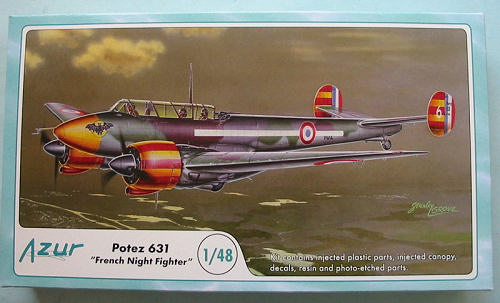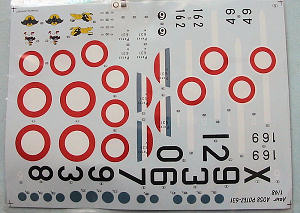
| KIT: | Azur 1/48 Potez 631 |
| KIT #: | ? |
| PRICE: | £23.00 export from Hannants |
| DECALS: | Three options |
| REVIEWER: | Tom Cleaver |
| NOTES: |

| HISTORY |
The Potez 63 was originally designed in answer to a French Air Ministry specification issued October 31, 1934, for a Multiplace legere de Defense, or light, multi-seat defensive aircraft. The specification called for an aircraft able to perform the roles of fighter control (three-seat C3) bomber escort; daylight interceptor (two-seat C2); and night-fighter (two-seat Cn2). The first prototype Potez 630 flew April 25, 1936. Ten more prototypes were tested before a production order was placed in 1937 for 80 Potez 630s, powered by two 580 h.p. Hispano-Suiza 14 radials, and 80 Potez 631s,powred by 670 h.p. Gnome-Rhone 14 Mars radials. A total of 702 production aircraft were built, including thee non-fighter versions. The Potez 633 B2, a light bomber version with a partially glazed nose ordered by Romania and Greece, though all but 21 were retained by France; the Potez 637 A3, a three-seat reconnaissance version with a ventral gondola for the observer; and the Potez 63-11 with an extensively redesigned fully glazed nose and a short crew canopy.
With a top speed of only 274 m.p.h., the Potez 631 suffered from the inability of the French aircraft industry to produce high-powered aircraft engines as the Germans and British had done. In the event, the only German bomber the Potez 631 would outperform was the He-111,with both the Do-17 and the Ju-88 being able to outrun it.
As the outbreak of war, the Armee de l’Air had 80 Potez 630s and 206 Potez 631s, with 117 in first-line units. In February 1940, the severely-underpowered Potez 630s were converted into dual control multi-engine trainers, and it was decided to up the armament of the Potez 631 from 2 20mm cannon and 2 7.62mm machine guns in the nose with a 7.62mm machine gun in the rear for defense, by adding four additional 7.62mm weapons under the wings. In the event, only two Potez 631s would fly with this armament before the armistice.
Following the German attack on May 10,1940, the Potez 631s were unable to intercept any German bombers at night. The French high command decided to commit the Potez631s to ground-attack missions. The first, by 18 Potez 631s against Wehrmacht units near Fourmies, resulted in the loss of six to German flak. On May 18, a Potez 631 finally succeeded in shooting down a He-111. During the Battle of France, the Potez 631s of the Armee de l’Air managed to shoot down 4 confirmed and 8 probables, for a loss of 10 to enemy action.
The two Aeronavale units, based at Calais-Marck, Escadrilles AC1 and AC2 of Flottille F1C, had the greatest success, shooting down 12 German aircraft over the North Sea for a loss of 8 of their own.
Called the French Me-110, the Potez 631 suffered from its similarity to the German twin, and three were shot down by their own side, in addition to several others being shot up.
Following the Armistice, 112 Potez 631s were deployed to Vichy France, with another 53 based in North Africa. When the Germans occupied Vichy in November 1942, they took over 134 Potez 63s of all variants, several of which were sent on to the Rumanian Air Force. Three of these were recaptured in September 1944 by the FFI and used by GR III/33 on recon missions over the German strongholds in the Atlantic pocket over the remaining months of the war. These were used after the war at the Flight Research Center for rocket tests.
| THE KIT |
 Azur has produced the Potez 631 in 1/72 scale, and this 1/48 kit is essentially
a scale-up of that kit.
Azur has produced the Potez 631 in 1/72 scale, and this 1/48 kit is essentially
a scale-up of that kit.
The parts fit is remarkably better than one normally associates with an MPM
product, as if some central group did all the design of the plastic and resin
parts. As it turns out, th e
kit was designed in France and produced by MPM. Test-fitting reveals that if one
cleans up all the parts, there will be very little fiddling in construction.
Sanding down the trailing edges of the wings before assembly will result in very
fine sharp surfaces. Overall, everything fits well.
e
kit was designed in France and produced by MPM. Test-fitting reveals that if one
cleans up all the parts, there will be very little fiddling in construction.
Sanding down the trailing edges of the wings before assembly will result in very
fine sharp surfaces. Overall, everything fits well.
The two resin engines are beautiful molds, and cockpit has sufficient detail to look good under the long glass canopy.
Decals are provided for three Potez 631s, including one from Flotille F1C of the Aeronavale, the most successful unit during the Battle of France, one from an Armee de l’Air unit, and one from the Vichy Air Force with the “slave’s pajamas” markings of yellow and red stripes.
| CONCLUSIONS |
This is a very nice kit of a significant French fighter, and as such deserves a place in any representative collection of French aircraft of the Second World War. The kit is significantly better than most limited-run kits as regards design and production standards, and will result in a good-looking model.
Review kit courtesy of Hannant’s. Get yours at http://www.hannants.co.uk
Sept 2006
If you would like your product reviewed fairly and quickly by a site that has over 325,000 visitors a month, please contact me or see other details in the Note to Contributors.